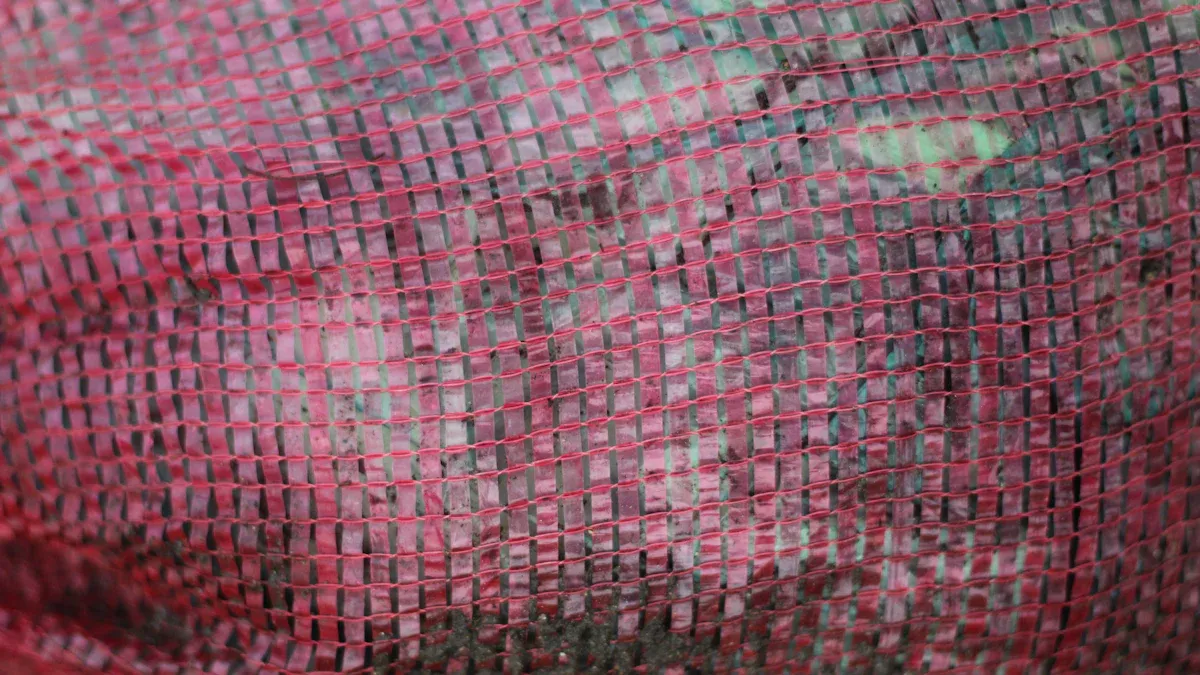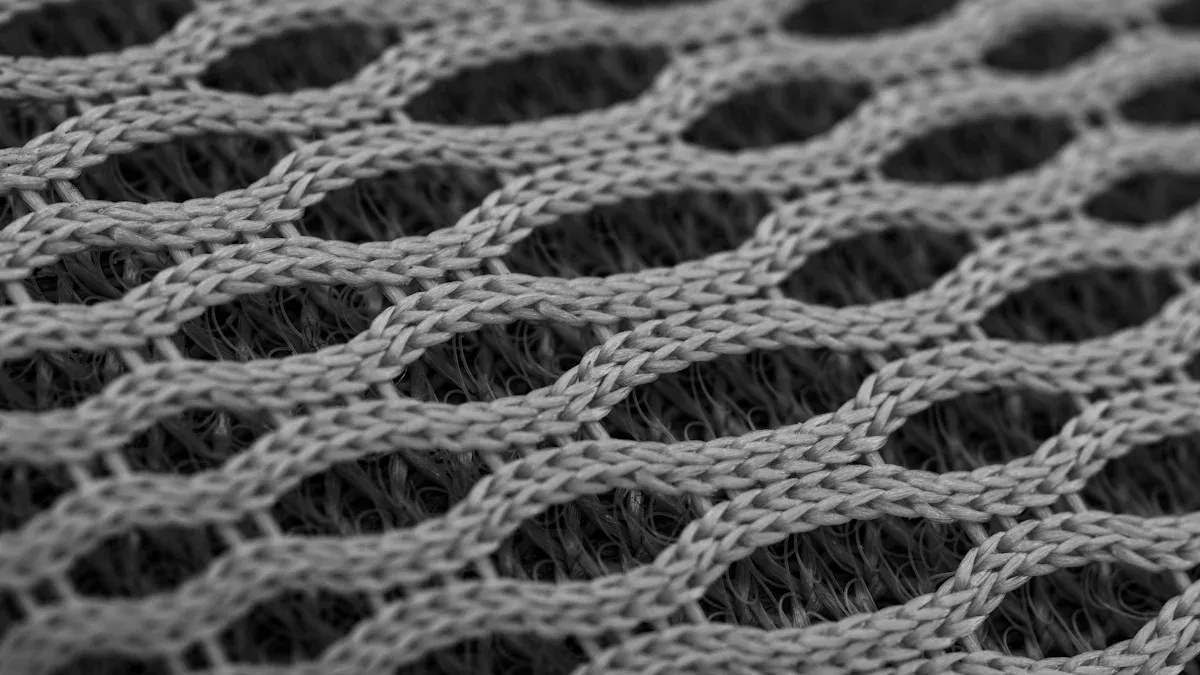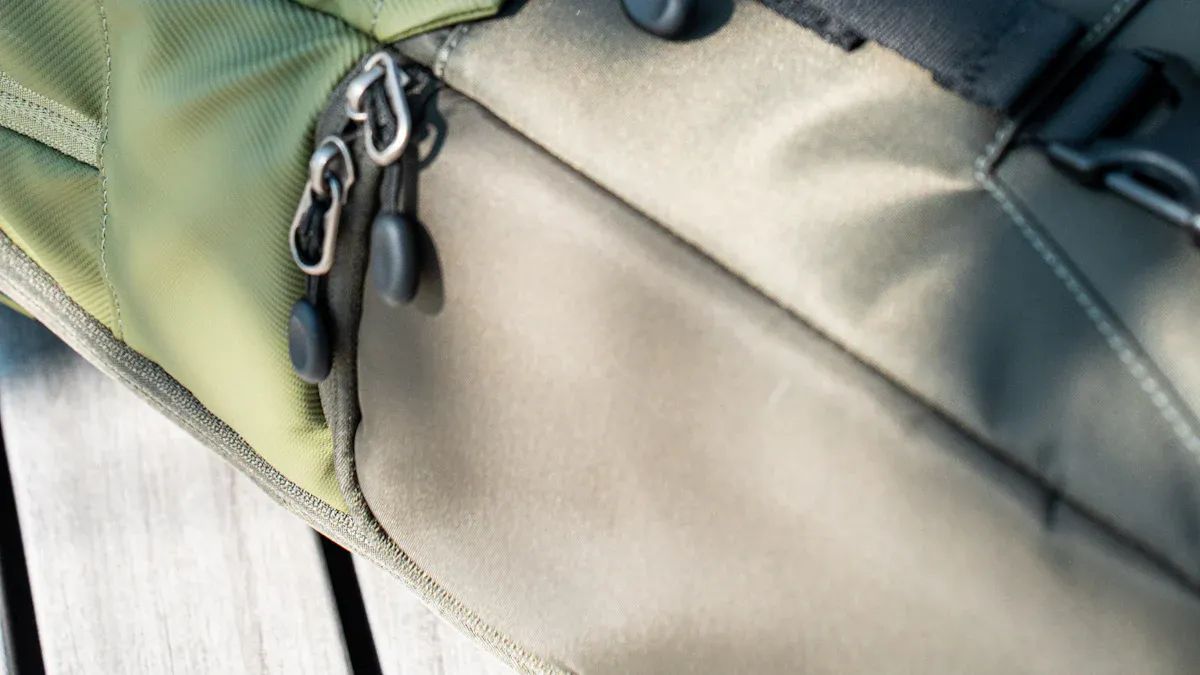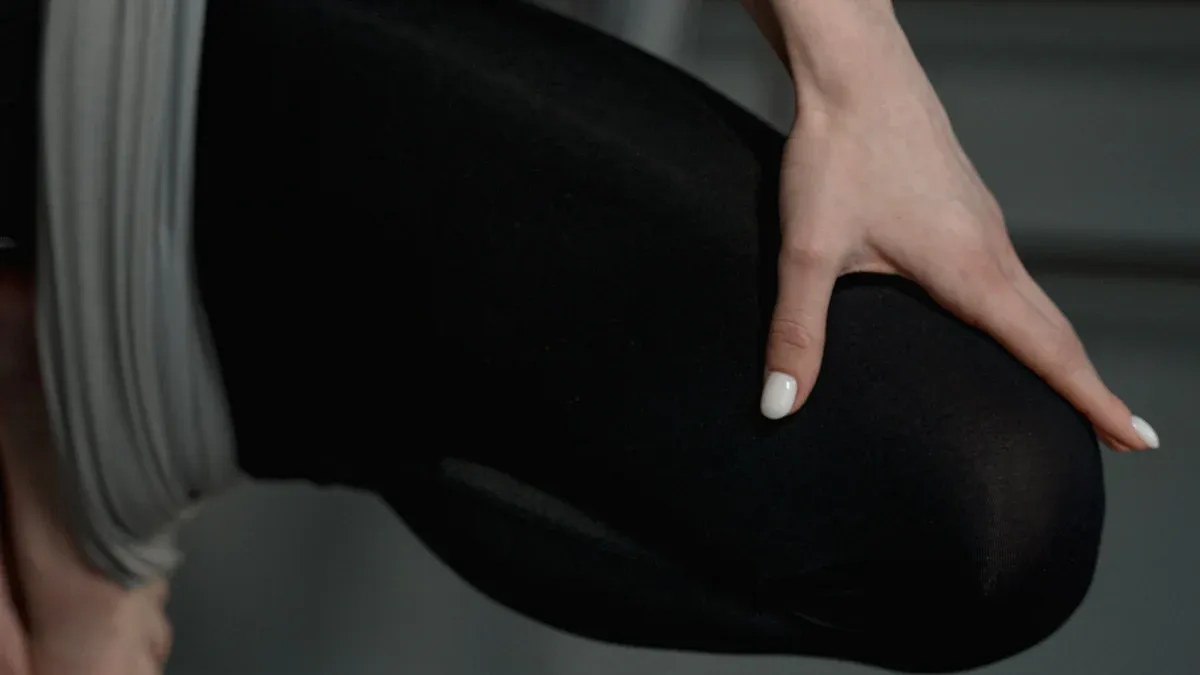
You rely on fabric mesh netting material for your favorite outdoor gear because it delivers unmatched versatility. This material keeps you cool and comfortable during camping, hiking, and sports by allowing air to flow freely and moisture to escape. Scientific studies show that mesh netting provides excellent breathability and adapts well in changing weather, offering both protection and comfort. Its lightweight design makes your gear easy to carry, while durable fibers stand up to tough outdoor conditions. You enjoy how these flexible fabrics enhance every adventure.
- Many outdoor activities benefit from mesh netting:
- Camping and hiking
- Outdoor rest stops
- Inflatable pads for portable comfort
- Sportswear and activewear
Key Takeaways
- Mesh fabric keeps you cool and dry by allowing air to flow and moisture to escape, making outdoor activities more comfortable.
- This material is lightweight, strong, and quick-drying, so your gear stays easy to carry and lasts through tough conditions.
- Mesh adapts to your movements with flexibility and stretch, helping you stay comfortable during hiking, running, or camping.
- You find mesh in many outdoor products like backpacks, tents, clothing, shoes, and organizers, improving breathability and convenience.
- Proper care, like gentle washing and quick repairs, helps your mesh gear stay durable and ready for many adventures.
Key Properties of Fabric Mesh Netting Material in Outdoor Gear

What Makes Mesh Special for Outdoor Use
You notice the difference when you choose mesh for your outdoor gear. Mesh fabric stands out because of its open-weave design and unique structure. This design allows air to flow freely, keeping you cool and comfortable even in hot weather. The materials used, such as polyester and nylon, resist water, UV rays, and daily wear. You benefit from a lightweight yet strong fabric that does not stretch, sag, or tear easily. Mesh dries quickly and resists mold and mildew, making it easy to clean and maintain. These features make mesh fabric a smart choice for outdoor adventures.
- Open-weave structure for superior airflow and breathability
- Durable materials like polyester and nylon for strength and resistance
- Lightweight and flexible, yet tough against stretching and tearing
- Quick-drying and moisture-wicking to prevent mold and mildew
- Easy to clean and maintain for long-lasting use
Main Characteristics of Mesh Netting Material
Mesh fabric offers several key characteristics that improve your outdoor experience. The breathable mesh fabric has evenly spaced holes, which promote airflow and keep you dry. Polyester mesh provides excellent water and UV resistance, while nylon mesh delivers extra durability. The stretch and flexibility of mesh fabric allow you to move freely. Moisture-wicking properties help keep you comfortable and make cleaning simple. Mesh fabric’s breathable structure ensures you stay cool and dry, even during intense activities.
- Breathable mesh fabric with open structure for airflow
- High durability and abrasion resistance
- Water and UV resistance, especially in polyester mesh
- Stretch and flexibility for comfort and movement
- Moisture-wicking to resist mold and mildew
How Mesh Compares to Other Outdoor Fabrics
When you compare mesh to other outdoor fabrics, you see clear advantages. The breathable nature of mesh fabric sets it apart from solid fabrics, which can trap heat and moisture. Mesh fabric’s lightweight feel makes your gear easier to carry. Its quick-drying and moisture-wicking abilities help you stay comfortable in changing weather. The table below shows how pore size and weave pattern affect mesh performance:
| Aspect | Effect of Pore Size (e.g., 100 Micron) | Effect of Weave Pattern (Plain vs Twill) |
|---|---|---|
| Filtration Efficiency | Smaller pores enable finer filtration, crucial for particle separation and purity. | Plain weave provides a stable, level surface ideal for general filtration; twill weave adds diagonal threads for enhanced strength and durability, suitable for heavy-duty filtration. |
| Strength & Durability | N/A | Twill weave offers greater strength and wear resistance compared to plain weave, making it better for demanding applications. |
| Flexibility | N/A | Plain weave is more adaptable and flexible; twill weave balances flexibility with added robustness. |
| Outdoor Suitability | Smaller pores maintain filtration precision under outdoor conditions. | Coated meshes (e.g., polyurethane or vinyl) improve resistance to UV rays, chemicals, and wear, extending lifespan and maintaining performance outdoors. |
| Breathability & Comfort | Smaller pores may reduce airflow but improve filtration; balance needed. | Weave pattern influences air circulation; mesh fabric’s breathability and lightweight nature improve comfort by reducing heat and moisture buildup. |
You gain the benefits of choosing mesh fabric when you want gear that is light, strong, and comfortable. Mesh fabric’s breathable mesh fabric and breathable structure make it a top pick for outdoor gear.
Advantages of Mesh in Outdoor Gear
Breathability and Moisture Management
You want your outdoor gear to keep you comfortable in every condition. Mesh fabric stands out because of its breathable nature. The open structure of breathable mesh fabric allows air to move freely, which helps your body stay cool during intense activities. You avoid overheating and feel fresh, even on hot days. Mesh also excels at moisture-wicking. When you sweat, the fabric pulls moisture away from your skin and lets it evaporate quickly. This feature keeps you dry and reduces the risk of chafing or discomfort.
You benefit from mesh because it dries fast after rain or washing. Mold and mildew do not build up easily, so your gear stays clean and ready for your next adventure. The lightweight and breathable qualities of mesh make it a top choice for outdoor gear that needs to perform in changing weather.
Tip: Choose gear with breathable mesh fabric for activities like hiking, running, or camping. You will notice better airflow and less moisture buildup.
Lightweight and Packability for Outdoor Activities
You need gear that is easy to carry and store. Mesh fabric is lightweight, so it does not add extra weight to your backpack. You can pack more items without feeling weighed down. The lightweight and breathable design of mesh means you can fold or roll your gear into a small space. This makes it simple to fit everything you need for your trip.
The packability of mesh netting material directly affects how portable your outdoor gear is. The table below shows how different pack sizes and mesh types impact portability:
| Pack Size / Weight / Mesh Type | Properties | Impact on Portability |
|---|---|---|
| Small Packs (20x15x5 cm) | Compact, lightweight, easy to store | High portability due to small size and low weight |
| Medium Packs (30x25x10 cm) | Balanced size and capacity, manageable weight | Moderate portability with increased capacity |
| Large Packs (50x40x20 cm) | Large capacity, heavier and bulkier | Reduced portability due to size and weight |
| Lightweight Packs (50-200g) | Thin, minimal weight, basic functionality | Very high portability, easy to carry |
| Medium Weight Packs (201-500g) | Balanced durability and handling | Good portability with functional capacity |
| Heavy-Duty Packs (>500g) | Thick, robust, high capacity | Lower portability, more cumbersome |
| Medium Mesh | Balanced breathability and visibility | Allows compact packing with structural integrity |
| Coarse Mesh (5-10 OPI) | Highly breathable, less dense | Enhances breathability but may affect compactness |
You see that mesh fabric helps you pack efficiently. You can choose the right size and weight for your needs, making your outdoor experience more enjoyable.
Durability and Strength in Demanding Conditions
You expect your gear to last through tough adventures. Mesh fabric delivers impressive durability. Manufacturers test mesh under extreme outdoor conditions, including repeated washing, exposure to sun, and heavy use. For example, some mesh fabrics withstand up to 35 washes without showing wear. They also maintain color and performance after exposure to sweat and sunlight.
Mesh with vinyl coating resists water, UV rays, mildew, tearing, and abrasion. This means your gear stays strong and reliable, even in harsh environments. Special treatments, like UV inhibitors and protective coatings, help mesh keep its strength after long hours in the sun or rain. Black-dyed nylon netting, for example, blocks UV rays and slows down fiber breakdown. Knotted construction adds extra toughness for direct impact use.
- Mesh fabric maintains durability under heavy use and extreme weather.
- Coatings and treatments protect against UV and moisture damage.
- Darker colors and solution-dyed fabrics offer better UV resistance.
- High initial tensile strength helps mesh last longer, even with some strength loss over time.
You can trust the durability of mesh fabric for your outdoor gear. It stands up to repeated use, rough handling, and changing weather. You get reliable performance every time you head outdoors.
Flexibility and Comfort in Outdoor Gear
You want your outdoor gear to move with you, not against you. Mesh netting material gives you this freedom. The fabric bends, stretches, and adapts to your body and your gear’s shape. This flexibility means you can hike, climb, or camp without feeling restricted. You notice the difference when you wear a backpack with mesh straps or sit in a camp chair made from mesh. The material supports your movements and keeps you comfortable for hours.
Ergonomic studies highlight the importance of breathability, softness, and stretch in clothing comfort. These qualities help reduce discomfort like stickiness or roughness, especially during exercise or outdoor activities. Mesh netting material excels in these areas. The open knit structure allows air to flow, which keeps you cool and dry. The fabric’s stretch lets it conform to your body, providing a custom fit that feels natural. When manufacturers add spandex to mesh, you get even more elasticity. The mesh stretches and returns to its original shape, so your gear stays supportive and flexible.
Note: You experience less fatigue and more comfort when your gear adapts to your movements. Mesh netting material helps you stay active longer.
You also benefit from the adaptability of mesh in different outdoor designs. Flexible mesh fabrics like polyester and nylon work well in backpacks, tents, and clothing. Polyester mesh is lightweight and comfortable, making it a favorite for athletic wear and outdoor gear. Nylon mesh adds strength and resilience, so your gear lasts through many adventures. The lightweight and breathable nature of mesh means you can wear or carry your gear without feeling weighed down.
Here are some ways flexibility and comfort improve your outdoor experience:
- Mesh adapts to different shapes and structures, fitting your body and gear perfectly.
- The open weave design increases airflow, which helps regulate temperature and moisture.
- Stretchy mesh with spandex offers controlled flexibility, so your gear moves with you.
- Lightweight mesh reduces bulk, making your gear easier to pack and carry.
- Durable mesh stands up to repeated use, so you do not need to replace your gear often.
| Feature | Benefit for Outdoor Gear |
|---|---|
| Flexibility | Adapts to movement and gear shapes |
| Lightweight | Reduces fatigue and increases comfort |
| Breathability | Keeps you cool and dry |
| Stretch and Recovery | Maintains fit and support |
| Durability | Withstands outdoor conditions |
You want gear that feels good and works hard. Mesh netting material delivers both. The combination of flexibility, lightweight design, and comfort makes mesh a top choice for modern outdoor gear. You stay cool, dry, and ready for any adventure.
Applications of Fabric Mesh Netting Material in Outdoor Gear

Backpacks and Storage Solutions (e.g., Suerte mesh pockets)
You rely on your backpack to organize and protect your essentials during every adventure. Mesh netting material plays a vital role in modern backpack design. You find mesh pockets on the sides and front of many backpacks, including those from Suerte. These pockets offer quick access to water bottles, snacks, and maps. The open structure of mesh allows air to circulate, which helps reduce moisture buildup and keeps your items dry. You benefit from the lightweight nature of mesh, which keeps your backpack easy to carry even when fully loaded.
Mesh fabric stands up to rugged outdoor use. It resists tearing and stretching, so you can trust it to hold up on rough trails. The applications and uses of mesh fabric in backpacks include:
- Enhancing breathability and reducing moisture inside storage compartments
- Providing lightweight, tear-resistant pockets for quick access to essentials
- Improving ventilation to keep your gear fresh and dry
- Adding flexible storage options that adapt to different shapes and sizes
You notice that mesh pockets make your camping gear more organized and accessible. The durability and adaptability of mesh netting material ensure your backpack remains reliable in any environment.
Tents, Shelters, and Outdoor Protection
When you set up your tent or shelter, you want protection from insects and the elements without sacrificing comfort. Mesh netting material delivers both. In tents like the Breeze Mesh Tent, fine mesh acts as a barrier against mosquitoes and small insects. You enjoy excellent airflow, which keeps the inside of your shelter cool and comfortable. The mesh canopy lets you see the stars at night, showing its breathability and visibility.
You can use a mesh tent alone on clear nights for maximum ventilation and insect protection. When you combine it with a tarp, you create a lightweight and versatile shelter system. The mesh keeps bugs out while the tent floor protects you from ground moisture. Many outdoor enthusiasts choose mesh tents for ultralight backpacking because they balance ventilation and insect defense so well.
Here are some common uses of mesh in tents and shelters:
- Creating no-see-um barriers to block even the smallest insects
- Allowing for stargazing and visibility while maintaining protection
- Supporting airflow to prevent condensation and overheating
- Forming part of modular camping equipment systems for flexibility
You experience greater comfort and safety in your outdoor shelter thanks to the thoughtful applications of mesh fabric.
Outdoor Clothing and Apparel
You need clothing that keeps you comfortable during every outdoor activity. Mesh netting material excels in outdoor clothing and apparel, especially in sportswear and activewear. The open, porous weave of mesh fabric for clothing allows maximum airflow. This ventilation prevents overheating by letting heat escape and helps sweat evaporate quickly. You stay dry and comfortable, even during intense activities.
Mesh forms warm air pockets between its weaves, providing more warmth for the weight compared to closed-weave baselayers. This structure helps regulate your body temperature by allowing air to circulate and cool you down when needed. Mesh’s lightweight and quick-drying properties make it ideal for sportswear, activewear, and other outdoor gear. You find mesh panels in jackets, shirts, shorts, and even hats, all designed to improve breathability and comfort.
The uses of mesh fabric in clothing include:
- Enhancing thermal regulation for better comfort during physical activity
- Promoting rapid moisture evaporation to keep your skin dry
- Reducing weight while maintaining warmth and protection
- Providing flexibility and stretch for ease of movement
You benefit from the proven performance of mesh in extreme conditions. Mesh baselayers have kept explorers warm and dry on historic expeditions, showing the lasting value of this material in outdoor clothing and camping equipment. Today, you enjoy the same advantages in your sportswear and activewear, making every adventure more enjoyable.
Footwear and Performance Shoes
You depend on your shoes for every step outdoors. Mesh plays a key role in modern performance footwear, especially for hiking, running, and trail activities. When you choose shoes with mesh, you notice the difference right away. The open-weave structure lets air flow around your feet, keeping them cool and dry even during long hikes or intense runs. This breathability helps prevent heat and moisture buildup, which can cause discomfort or blisters.
Mesh shoes feel light on your feet. The lightweight construction reduces fatigue and strain, so you can move faster and farther without feeling weighed down. You also benefit from the flexibility of mesh. The material adapts to the shape of your foot, giving you a comfortable fit and reducing the risk of blisters. When you combine mesh with cushioned insoles and sturdy outsoles, you get support and comfort for many outdoor activities.
You find advanced mesh types in high-performance shoes. Engineered mesh and double-layer mesh offer extra durability and targeted support. These features make your shoes last longer, even in rugged conditions. Mesh also works well in sportswear and activewear, where you need both comfort and performance.
Here are some advantages of mesh in footwear:
- Lightweight design minimizes strain and boosts comfort.
- Open-weave mesh provides maximum ventilation, keeping feet cool and dry.
- Moisture-wicking ability pulls sweat away from your skin.
- Flexible mesh adapts to your foot shape, reducing blisters.
- Advanced mesh types add durability and support for tough terrain.
- Breathable mesh helps prevent foot problems during long or hot activities.
Tip: Choose mesh shoes for hiking, running, or any outdoor sport where breathability and comfort matter most. You will notice less fatigue and more enjoyment on every adventure.
Outdoor Accessories and Organizers
You use many accessories and organizers to keep your outdoor experience smooth and efficient. Mesh stands out in these applications because it combines visibility, breathability, and strength. You often see mesh in storage pouches, gear organizers, and utility bags. The open structure lets you see what’s inside at a glance, so you can quickly grab what you need.
Mesh organizers keep your equipment dry and fresh. Air flows through the fabric, which helps prevent moisture buildup and odors. You can store wet or damp items, like towels or swimwear, without worrying about mold. Mesh pockets in backpacks or jackets hold small essentials, such as snacks, maps, or tools, within easy reach.
Sportswear and activewear brands use mesh in hats, gloves, and even belts. These accessories benefit from the same breathability and lightweight feel as mesh fabric for clothing. You stay comfortable and organized, whether you are on a day hike or a multi-day camping trip.
Here are some common uses for mesh in outdoor accessories:
- Storage pouches for quick-drying and easy visibility
- Gear organizers for separating clean and dirty items
- Mesh pockets in backpacks, jackets, and vests
- Breathable hats, gloves, and belts for added comfort
- Utility bags for carrying sportswear and activewear
| Accessory Type | Mesh Benefit | Example Use |
|---|---|---|
| Storage pouch | Quick drying, visibility | Wet towels, swimwear |
| Backpack pocket | Breathability, flexibility | Snacks, maps, tools |
| Utility bag | Lightweight, strong | Carrying sportswear |
| Hat/glove/belt | Comfort, moisture control | Outdoor sports and activities |
Note: Mesh accessories help you stay organized and comfortable. You save time and effort when your gear is easy to find and stays fresh.
Choosing the Right Mesh Netting Material for Outdoor Gear
Material Types and Their Outdoor Benefits
You have many options when selecting mesh fabric for outdoor gear. Each type offers unique benefits for different environments and uses.
- Polyethylene, polypropylene, and nylon netting give you lightweight strength. These materials resist UV rays and chemicals, making them ideal for bird netting, fencing, and marine gear.
- Rope netting uses high-strength fibers like polypropylene or nylon. You get flexibility and durability, which work well for outdoor and maritime settings.
- Cable netting, made from steel cables, provides high load-bearing capacity. This type suits safety barriers and heavy-duty outdoor needs.
- Stainless steel netting (304/316) stands out for corrosion resistance. You can use it in harsh marine or chemical environments with confidence.
- Merino wool mesh offers natural temperature regulation and odor resistance. You stay comfortable during multi-day trips.
- Synthetic mesh, such as polyester or nylon, dries quickly and resists wear. You benefit from cost-effective, moisture-wicking, and durable gear.
Tip: Choose mesh fabric based on your activity and environment. For example, use stainless steel for harsh conditions and synthetic mesh for lightweight, breathable mesh fabric.
Strength, Weight, and Durability Considerations
You want your gear to last and perform well. Consider these factors when choosing mesh fabric:
- Fabric weight: Heavier mesh fabric increases durability and tear resistance. Lighter mesh improves flexibility and breathability.
- Color: Dark colors absorb heat, while light colors reflect it. This affects comfort in the sun.
- UV resistance: Essential for outdoor use to prevent fading and weakening.
- Chemical resistance: Important if your gear faces chemicals or saltwater.
- Flame retardancy: Needed for fire-prone areas.
- Breathability: Critical for airflow and moisture management, especially in sportswear.
- Cost: Balance performance with your budget.
- Manufacturer reputation and quality control: Ensure you get reliable, high-quality mesh fabric.
- Customization and environmental impact: Look for eco-friendly options like recycled nylon.
Manufacturers test mesh fabric using abrasion and tensile strength tests. The Martindale and Wyzenbeek tests measure how well the fabric resists rubbing and tearing. These tests help you trust the durability of your gear.
| Factor | Why It Matters |
|---|---|
| Fabric weight | Affects durability, flexibility |
| UV resistance | Prevents fading, extends life |
| Breathability | Keeps you cool and dry |
| Durability | Withstands outdoor use |
Care and Maintenance for Outdoor Mesh Gear
You extend the life of your outdoor gear with proper care. Follow these steps to keep your mesh fabric in top shape:
- Sort gear by material before washing. Use mild, eco-friendly detergents and avoid bleach.
- Wash durable items on a gentle cold cycle. Hand wash delicate or waterproof gear to protect coatings.
- Always air dry your gear. Avoid direct sunlight and high heat to prevent damage.
- Inspect gear regularly for wear, such as fraying seams or thinning fabric. Repair small holes with mesh-specific patches or UV-resistant thread.
- Reapply water-repellent treatments if you notice water soaking in.
- Store gear in a cool, dry place using breathable containers. Clean and dry gear before long-term storage.
- Learn basic sewing to fix holes and seams. Prompt repairs prevent bigger problems.
Note: Regular maintenance and quick repairs help you enjoy the benefits of choosing mesh fabric for many adventures.
You see the versatility of fabric mesh netting material in every piece of modern camping gear. Construction contractors value its strength and adaptability for long-lasting performance. Farmers trust its weather resistance for reliable protection. Artisans use it for creative projects, showing its moldability. You get unmatched comfort and protection in your camping equipment. When you choose the right mesh for camping, you make every adventure safer and more enjoyable. Suerte offers high-quality solutions for all your outdoor needs.
FAQ
What makes mesh netting material ideal for outdoor gear?
You benefit from mesh netting because it offers breathability, strength, and flexibility. The open weave lets air flow, which keeps you cool and dry. The material resists wear and dries quickly, making it perfect for outdoor use.
How do you clean and care for mesh outdoor gear?
You should wash mesh gear with mild detergent and cold water. Air dry your items away from direct sunlight. Regularly check for damage and repair small holes quickly. This routine helps your gear last longer.
Can mesh netting material handle harsh weather?
You can trust mesh netting to perform well in tough conditions. Many mesh fabrics resist UV rays, moisture, and abrasion. Coated mesh adds extra protection, so your gear stays strong in sun, rain, or wind.
Where do you find mesh netting in outdoor products?
You see mesh netting in backpacks, tents, jackets, shoes, and organizers. Mesh pockets, panels, and linings improve airflow and comfort. You also find mesh in hats, gloves, and storage pouches.
How does mesh compare to solid fabrics in outdoor gear?
You notice mesh feels lighter and cooler than solid fabrics. Mesh lets air and moisture escape, which helps you stay comfortable. Solid fabrics offer more wind and water resistance, but mesh gives you better breathability.



